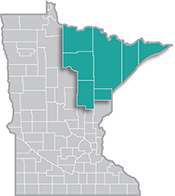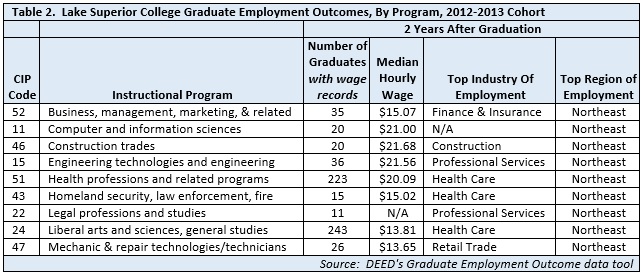 Home to the state's second-largest metro, the Northeast Region has a strong industrial sector, tied largely to the area's abundant natural resources.
Home to the state's second-largest metro, the Northeast Region has a strong industrial sector, tied largely to the area's abundant natural resources.
Most of the manufacturing base centers on mining and forest products industries. More than half of the sector's employment is in paper and machinery manufacturing.
Want the freshest data delivered by email? Subscribe to our regional newsletters.
5/2/2016 12:04:56 PM
Erik White
The Graduate Employment Outcomes (GEO) data tool shows how graduates of Minnesota post-secondary institutions are doing in the state’s labor market after completing their programs. This partnership between DEED and the Office of Higher Education (OHE) provides information about the wage earnings, industry and region of employment, and full-time employment status of graduates from Minnesota schools.
These outcomes can also be filtered by other indicators, including: graduation year, school location, award type, institution type, and instructional programs. Information for each of Minnesota’s 141 higher education institutions and the academic programs offered was recently added as a selectable feature. Go here for the press release.
This wealth of information can help prospective students and their families find information on and make comparisons across specific schools and education programs. The tool can answer the following questions:
Together these data can help students make decisions on what educational programs to pursue and at what schools. The information can also help students and their families make decisions on how much educational debt to take on in comparison to potential future earnings from those programs.
An example of the valuable information that is available through GEO shows that Lake Superior College in Duluth had 653 graduates with wage records in Minnesota one year after graduation from all of its academic programs for the 2012-2013 academic year.
Of this subtotal of all graduates from 2012-2013 academic year, the median hourly wage 1 year after graduation was $14.98 and increased to $17.00 two years after graduation for those with wage records in Minnesota. The data also shows that Lake Superior College benefits the local labor force as 67.2 percent of all graduates from 2010-2013 earned wages in Northeast Minnesota (Table 1).

Students can also analyze specific programs that are offered at Lake Superior College using the GEO data. One of the largest programs, health professions and related, had 223 graduates with wage records in Minnesota from the 2012-2013 academic year, earning a median hourly wage of $20.09 just two years after graduation.
Liberal arts and sciences, general studies was the largest program with 243 graduates reporting wage records in Minnesota two years after graduation, receiving a median hourly wage of $13.81. Because many graduates from this program further their academic pursuits by enrolling in 4-year programs, the lower median wage also reflects the jobs that these graduates take while completing a bachelor’s or higher degree. Interestingly, the top industry of employment for these graduates was Health Care and Social Assistance, reflecting the opportunities that this industry offers in the region, especially for those who do not further their education after graduation with a liberal arts associate degree.
For all academic programs at Lake Superior College, the top region of employment was Northeast Minnesota, indicating the college’s importance in placing people in jobs that the regional economy offers (Table 2).

The GEO tool can provide invaluable information for those pursuing higher education and should be used to determine the outcomes that education institutions and programs offer throughout the state of Minnesota to make an informed decision about one’s own education pursuit. For more information about this data tool, contact your local Labor Market Analyst or DEED’s Helpline.
Contact Erik White at 218-302-8413